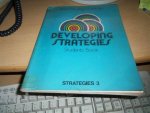There’s just no escaping gap-fill exercises for controlled practice (I’m using activity, exercise and task interchangeably in this post). When Headway came along in the mid 80s and grammar made its humongous comeback, gap-filling was catapulted back into ELT limelight and, since then, has pervaded every crevice of our profession, for both the right and the wrong reasons.Today, it’s probably the most prominent activity type in mainstream textbooks and, however much I may still yearn for Spectrum’s A-B exchanges or Strategies’ oral drills and quasi-communicative activities, there is clearly no going back. Gap-fill activities are here to stay. They’re easy to devise, easy to set out on the page of a textbook and easy to set up in class.
I take the view, though, that perhaps gap-fill is better suited for clarification purposes rather than controlled practice.
If we regard language learning as a form of skill learning (and I believe this is a contentious, but perfectly legitimate analogy), then we must offer controlled practice activities which bear as much resemblance to the “real thing” as possible and by that I mean spontaneous language use. In other words, you can’t learn how to swim by making ripples in the pool while standing outside, fully clothed. Neither can you learn how to drive by reading some sort of driving manual and then maneuvering the car in the parking lot.
There has got to be some sort of rehearsal so that the brain can become acquainted with the kinds of things it will be doing when the language is being used spontaneously. To me, gap-filling is just the very beginning of this rehearsal.
To be better able to grapple with the pressure of spontaneous communication, students need activities in which (1) they’re encouraged to create sentences rather than only manipulate them; (2) they can put meanings into words rather than the other way round and (3) there’s some sort of exchange of information and realistic purpose to complete the activity.
Click here for thirteen examples of how different practice activities can bear less or more resemblance to the spontaneous, real life communication.
And check out the BBC site, where a similar discussion took place in 2009.
Thanks for reading.




Yes, Luiz, the real thing!!! I couldn't agree with you more. Wonderful article!!!
🙂
Looking forward to part 2!! I was thinking about it today when I just tossed a gap-fill thing I was preparing – all of a sudden I felt it was such a pointless activity… Please help!! =]
Xxx
Vivi (Cult Jundiaí)
Hey, Vivi! Good to see you here!
Why did you feel it was pointless? What was the point of the activity? What were you trying to do? Gap fill lends itself well to a number of things, you know.